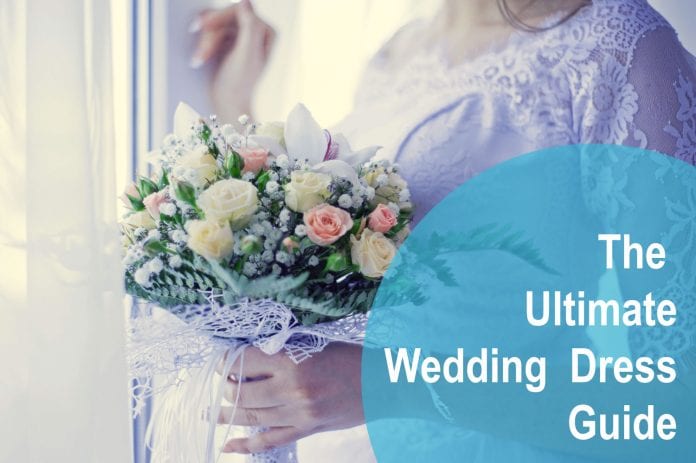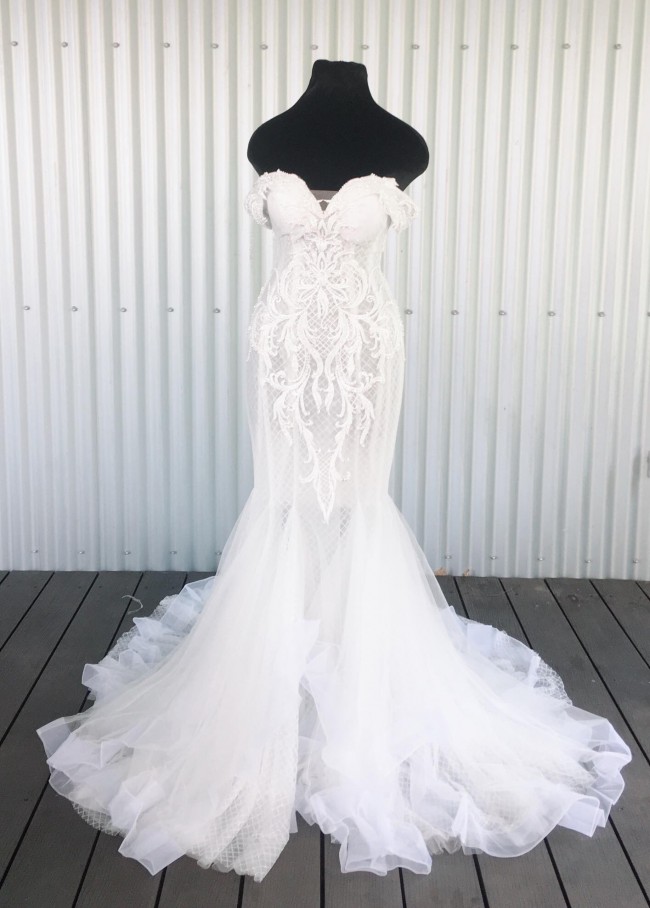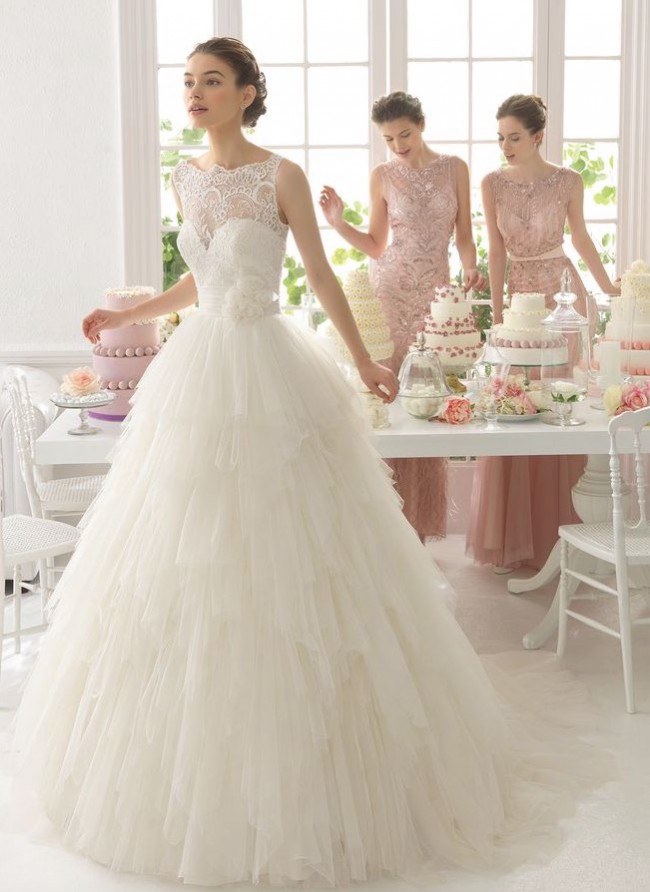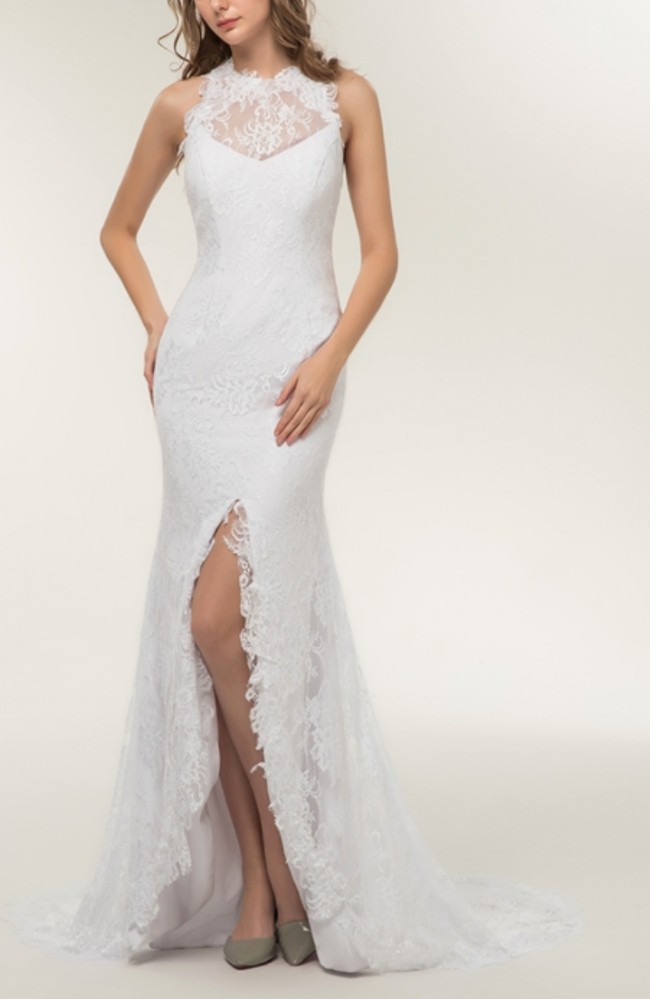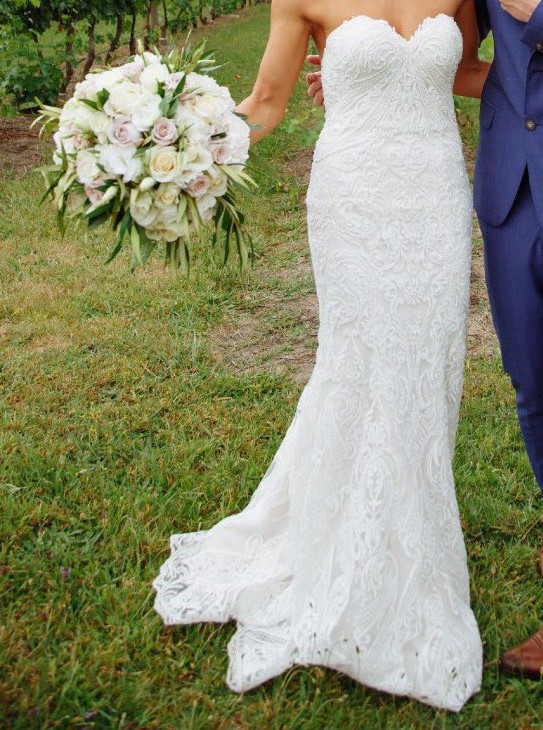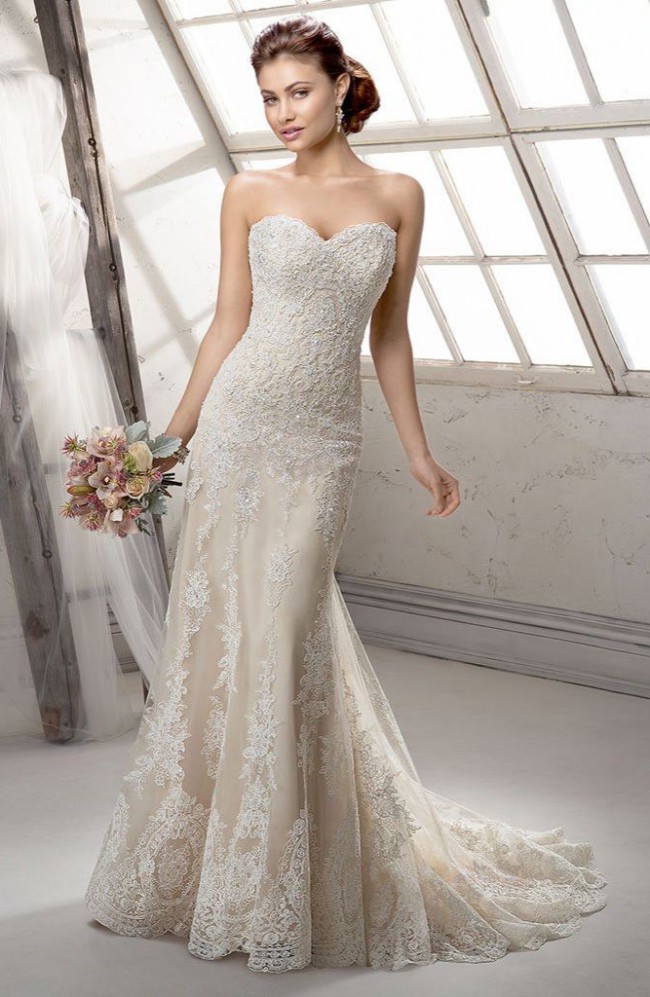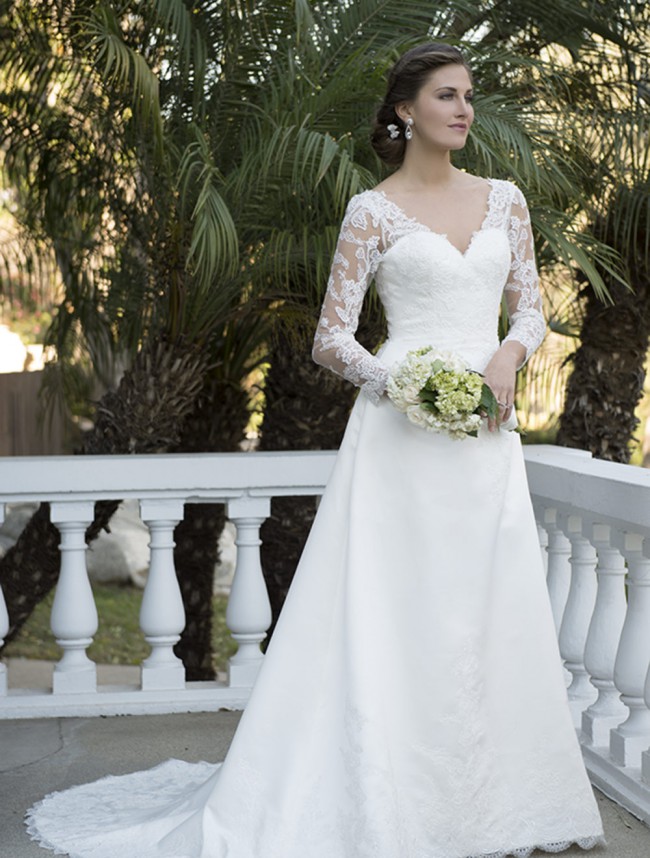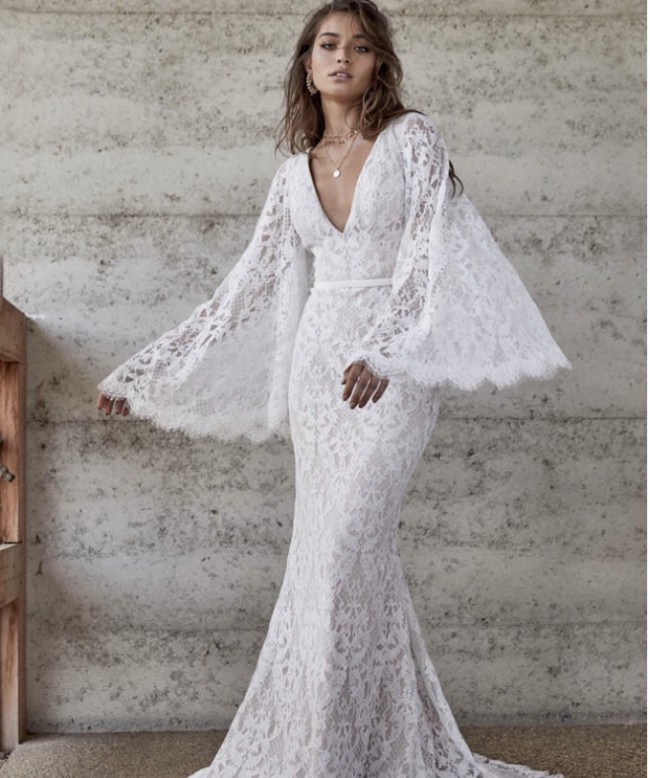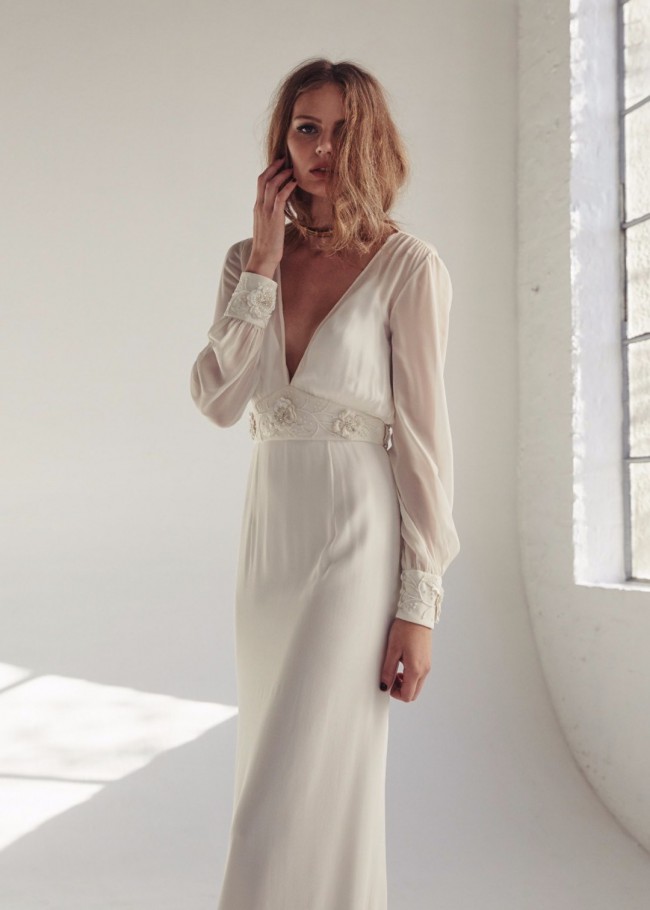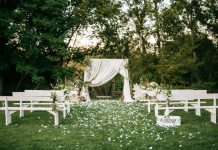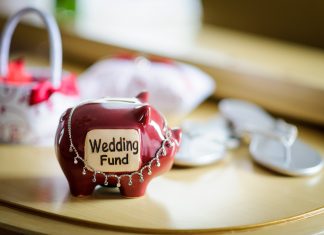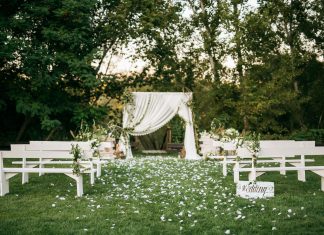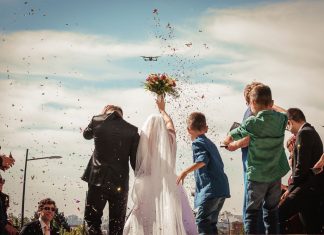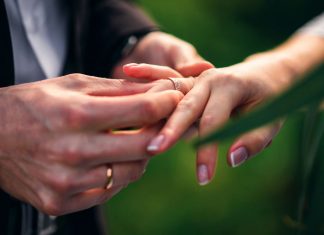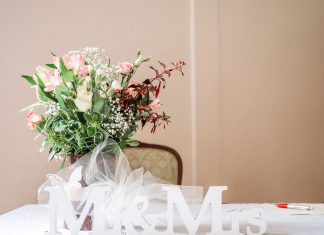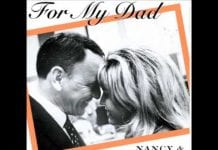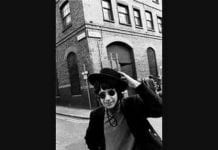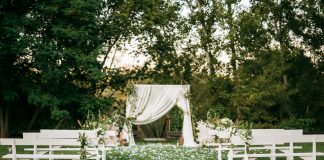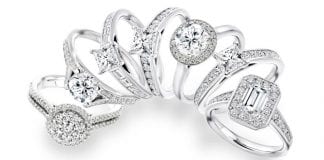Of all the arrangements and plans that go into a wedding, nothing sticks into people’s mind than the wedding dress. The big day is defined by the impression that the bride makes on those in attendance. No wonder a wedding dress is among the first things that cross your mind immediately you get engaged. For many, it is an opportunity to realize a little girl’s wedding dress dream.
What kind of a dress should I wear? What about the neckline? Is my body shape made for a specific dress style or should I go wild? What about acquiring the dress, should I hire or buy online? These are some of the questions that are sure to keep you awake as your day down the aisle approaches.
To give you a headstart on your quest, we have prepared the ultimate guide to a perfect wedding dress. We have broken wedding dress terminologies to give a simplified take on the different choices on wedding dress types, necklines, silhouettes, and sleeves. That’s not all, we have researched on where to buy your dream wedding dress, how to fit one and even how to protect your purchase. Indulge yourself below;
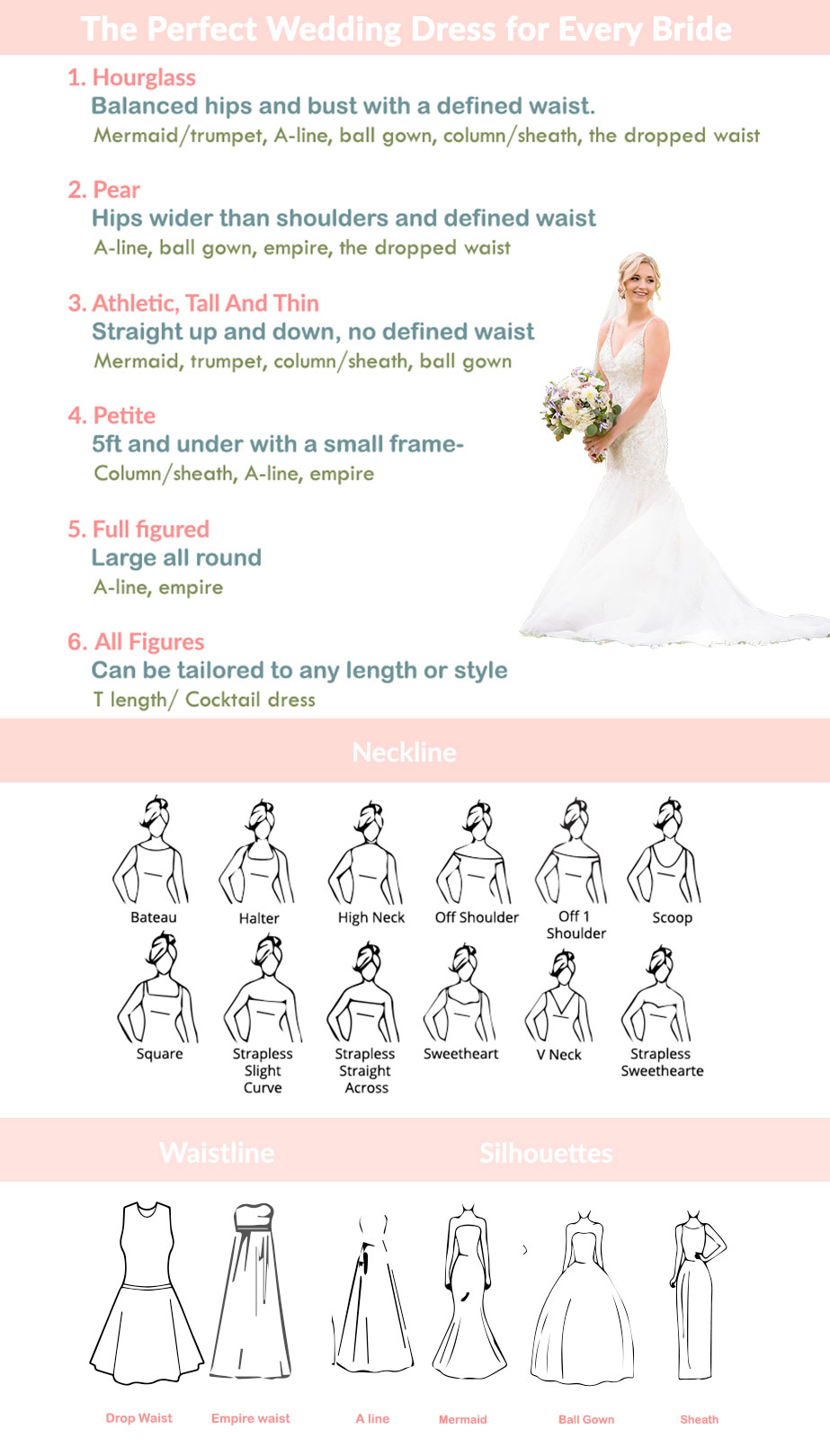
Wedding Dress Styles
Wedding dresses come in limitless details and designs. However, they all revolve around the following styles.
A-line Dress
The A-line dress is fitted at the bodice and then flows all the way in a straight line that creates an ‘A’ shape, hence the name A-line. The simplicity of this dress makes it suitable for any kind of wedding occasion.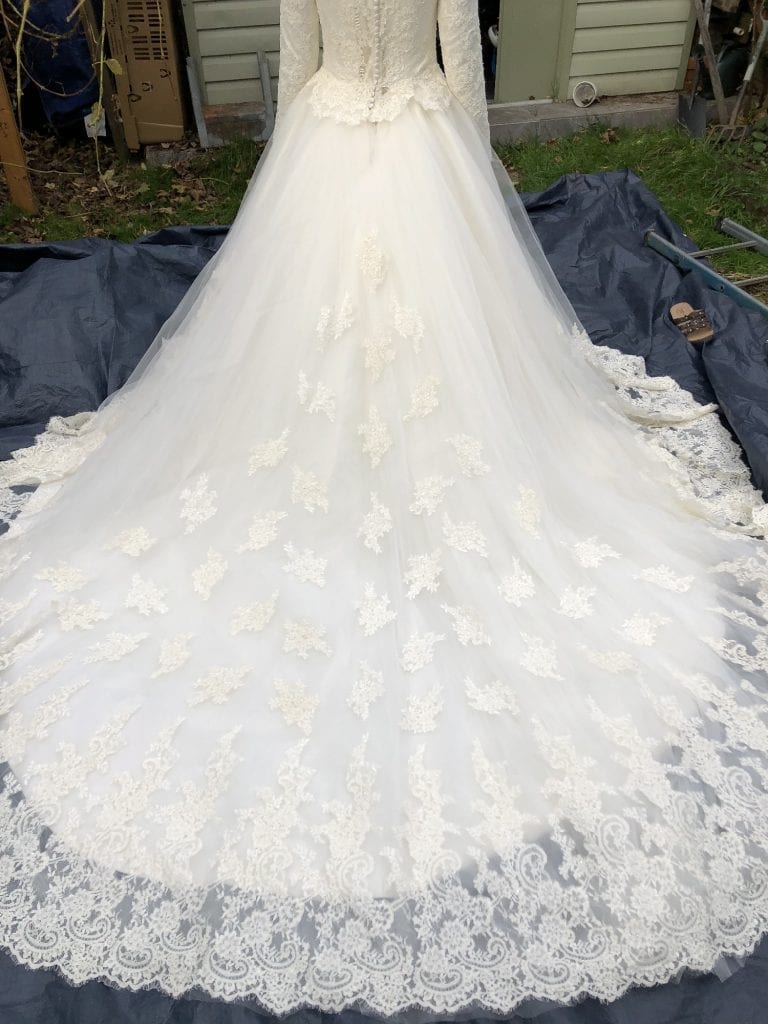
While it’s great for all body shapes, it particularly helps to balance out a large bust. It can also accentuate your waistline if you are full figured or apple shaped. This is especially so when it comes with embellishments at the bust or waistline.
Do you want to conceal a larger lower body or give a narrower one a curvier look; this is the dress to go for.
Another amazing thing about the A-line dress is its ability to hide your underwear especially from waist downwards. If you have never worn a thong and you shudder at the thought of one, this dress will forgive you for wearing practically anything or nothing under it.
Pro tip; If you are pear-shaped, A-line dresses with hip or thigh area decorations can exaggerate these parts.
Fishtail/Mermaid and Trumpet Dresses
The fishtail or mermaid dress and the trumpet dress are great for confident brides. This is because they highlight every curve on your body. They both hug the body from the bust down the hips; the trumpet flares out mid-thigh while the fishtail flares out at the knee.
The styles suit slender bodies but are perfect for showing off the hourglass figure. When it comes to choosing what to wear underneath them, panty lines and other bulges are a no-no. You might have to go with a thong-cut underwear or shapewear to smooth out everything.
Your shapewear should end where your dress starts to flare; anything that ends somewhere along the way might be noticeable.
Pro tip; this is not the best dress to hide any flaws, only go for it when you are absolutely confident.
Ball Gown Dress
Have you always wanted to feel like a princess on your wedding day? Here is your opportunity! The ball gown is one of the most popular and timeless wedding dresses. It is characterized by a fitted bodice and a full, dramatic skirt.
Also referred to as the princess dress, the ball gown is great at accentuating your waist. The full skirts helps to conceal larger hips in a pear-shaped woman, consequently keeping the attention at the bust. If your upper body is athletic, you can make the bust look fuller with embellishments. The dress can also give you an hourglass look if you have a large bust.
With a ball gown, you can go wild with sexy lingerie like corsets, garters and stockings or you can just try your patience with the bodice and go completely granny-panty-comfortable beneath the skirts.
Pro tip; If you are petite or on the shorter side, you might want to stay away from the ball gown since you might get lost therein. However, if your heart is set on the princess experience, less volume on the skirt might work.
Empire Dress
The empire dress is characterized by a high waistline that starts just below the bust while the rest of the gown flows all the way to the hem.
The dress is perfect for hiding anything that you want to hide from below the bust downwards such as a long torso, a large lower body characteristic of pear shaped women and short legs. Petite women can create an elongating illusion with this type of dress. It also suits small busted women well especially when it comes with embellishments that draw attention to the neckline or the sleeves.
Additionally, it is hard to notice a baby bump beneath the flowing skirt of the dress not to mention the comfort that it offers to mums-to-be.
What you choose to wear under your dress above the waist depends on the bodice that you choose to go with. The lower part on the other hand gives you the liberty to go as adventurous as you want or as simple as you can keep things. You won’t even have to worry about wearing shapewear with this one.
Sheath or Column Dress
The sheath or column dress is a relaxed, comfortable and trendy dress style. Unfortunately, it is also very unforgiving as far as unflattering bits are concerned since it closely fits the body from bodice to hem.
That said, the dress goes well with slim taller brides or those with athletic bodies. The dress also tends to create an illusion of added height for petite or short brides. The hour-glass shaped brides can also pull off a sexy look with the sheath dress. Statement backs, embellishments and lace can make the dress to stand out.
The column dress calls for seamless underwear and possibly shapewear to keep things smooth all the way. Bras tend to be especially visible beneath so you should take care of this beforehand or have yours sewn into the dress.
Pro tip; If you have some bulges and bumps, this dress tends to overemphasize them; you want to keep away from it.
The Dropped-Waist
This dress offers the perfect blend between a form fitting silhouette and a voluminous ball-gown look. It features a fitting bodice with a waist that is ‘dropped’ to rest just above or at the hips.
The look flatters the hourglass-figured brides or the pear shaped brides who don’t mind showing off their lower body assets.
The dress calls for careful selection of underwear to create a smooth look especially for the upper form fitting part. If you are into bridal hosiery, this dress will comfortably allow it.
Cocktail/ Tea Length Dress
If you are looking for a special, casual or informal look, a cocktail or a tea length dress might come in handy. These dresses don’t go the full length of the usual wedding gowns. Tea length dresses can come in different styles and lengths depending on personal preferences and choices.
The dresses can go with any body shape as there is no limit to the variety of style. Yours can be designed to highlight your assets and conceal the bits you would rather not flaunt.
What you wear under also depends on the particular dress. These dresses are particularly great for your reception; think of how easy it is to move around or even dance without having to worry about someone stepping on your skirt.
Wedding Dress Necklines
For whichever dress style you settle on, you have to decide on the neckline that will most flatter your look. Here is a look at the common necklines;
Sweetheart Neckline
As the name suggest, this neckline resembles the shape of a heart. The fabric is cut low to give the appearance of the upper part of a heart. With the shape running across the bust, it’s the epitome of femininity and playful romance. It also gives you an innocent and charming look.
The neckline works with both strapped and strapless dresses. It’s also perfect for small or big busted brides. Do you have strong facial features and you are looking for a way to smoothen your overall look, then this is the neckline for you; the soft curves of the ‘heart’ will draw attention from your face. Also, it allows you to show a little cleavage while adding balance and softness to the exposed neck and collar bones.
Strapless Neckline
Chic and elegant, does that sound like your style? If so, then a strapless neckline is what your wedding dress needs. The dress has no sleeves or straps attached to it. To support the dress, the top part runs under the arms and sits comfortably across the bust while being secured at the back.
These kinds of dresses can support any body shape but might not work for big busts- without straps, brides with larger busts can appear incorrectly postured. That said, a strapless dress is perfect for a lady with a long neck. Additionally, the neckline provides enough surface to showcase your wedding necklace.
V or Plunging Neckline
The neckline originates from two diagonal lines running from the shoulders and meeting at the cleavage. The ‘V’ can go as low as you wish or depending on the design. V-necks are extremely beautiful on apple shaped shapes. The style works best if you want to reduce the appearance of your bust.
If you have a small bust, it will look much minimal in this neckline. A big bust on the other hand will look smaller while accentuating your height. The plunging shape can also help in showing off a beautiful collar or choker necklace.
Halter Neckline
This is neckline define by a single strap that goes round the neck to offer support to the top. This unique style can also be made up of two straps originating from the bodice and meeting into a knot at the back of the neck. The style is flattering and a popular one with modern brides, who want to show off shoulders and arms.
It’s a stylish alternative to strapless dresses that features a high neck with a backless design. The back can however be covered and the front take different shapes depending on your preference. Exposing the upper arms can help in making a petite bride look taller. The design also takes care of loose underarm fabric that is usually seen in oversize strapless dresses.
Square Neckline
Formal yet elegant is what comes to mind with a square neckline. This is an angular shaped design with three linear edges across the chest. The straps that hold up the top do not cross but join at right angles, which create the appearance of a square or rectangular neckline. Some styles can have soft angles and slightly ‘cupped’ designs which adds to the femininity of the dress.
The angular appearance works best in balancing round faces or adding breadth to the chest and shoulders. The look also flatters brides who are big busted and want to keep their chest well covered, or just want to show a little cleavage.
Wedding Dress Sleeves
Sleeves are another part of wedding dress lingo that is bound to be confusing. From full-length and short-sleeves, intricate vintage and modern sleeves designs have become major fashion statements.
Most of these styles comprise of lace sleeves which may be attached onto the bodice, or sold separately. Here are some of the designs that will make your wedding dress pop.
Sleeveless or Strapless
As earlier noted, wearing a strapless dress gives you a chic and elegant appearance. Without any straps to attach sleeves to, the arms are well exposed which can work for bride with hand tattoos that need showing off. The style also goes well with loose hairstyles.
Cold Shoulder
Delicate neckline, lovely shoulders and beautiful collarbones, if this sounds like your strong features, then off-the-shoulder sleeves is what your dress needs. The look is modern and incorporates sleeves that originate below the shoulders. The style gives the appearance of strong shoulders while leaving space for showcasing statement necklace.
Whether the sleeves are draped or holding tightly to your body, they draw attention to the neck area and upper body. This can be flattering especially for apple body shapes which require eyes to be on the bodice- providing even better effect than what a strapless dress does.
Cap Sleeves
These are sleeves that just cover the shoulders without extending to the rest of the arm. The cut can be at or just below the armpit level. They have minimal fabric and are a nice addition to a dress with floral patterns. Cap sleeves are excellent in adding padding to your shoulders while leaving most of your biceps bare. The style is common with A-line dresses and square necklines.
Pro tip: Short sleeves can also do instead of caps. These are sleeves that hit halfway at the biceps or just below the shoulder; cinching the bicep or draping loosely.
Long Sleeves
If you want to draw away attention from your arms and on to your face then long sleeves are your kind of style. These sleeves are made of straight sheaths than can extend to or just before the wrists. Your dress will have a classic and authentic look. Long sleeves can also add a modern feel especially when paired with low-cut backs, V-necklines and lace embellishments.
3/4 Sleeves
These are a fitting alternative to long sleeves, especially for brides who want to show off wedding bracelets. The style also gives more room for mobility compared to long sleeves. They are also excellent for showcasing a little more of your amazing wedding dress fabric or decorations.
Bell Sleeves
Bell sleeves are a type of long sleeves with only one minor adjustment, they equipped with dainty bell-like flowing sleeves that go up to the wrists. They offer more mobility than sheath sleeves. Also, they add a carefree and breezy vibe to your dress.
Bell sleeves are inspired by the oldies, especially the 70’s clothing- think of hipster dresses and bellbottoms. If you are a modern bride with liking for colorful and fabulous occasions, then you should consider this style.
Bishop Sleeves
Unbound and easy going is what comes to mind with a bishop sleeve. The sleeve is cinched at the wrists while the fabric is loose and light weight, giving a romantic and elegant feel to your wedding dress. It’s a long sleeve which is fuller at the bottom compared to the top, and enfolded into a cuff. The style goes well with plunging necklines, low-cut backs and short wedding dresses.
Wedding Dress Fabric
When it all comes down to choosing your wedding gown fabric, the choices are limitless;
- Tulle- silk, rayon or nylon netting. It can be stiff or soft and is usually used on veils or to give skirts body and volume
- Satin- woven fabric that is glossy on the front and dull on the back
- Voile- Soft sheer fabric which can be made of cotton or a blend of cotton, linen and polyester
- Brocade- Heavy woven fabric with distinct raised designs
- Damask- It is brocade like but with textured designs
- Charmeuse- a semi-lustrous, soft and light-weight fabric
- Chiffon- A soft semi-transparent fabric popular with veils and layered skirts
- Linen- Fabric woven from flax. It is cooler and more lustrous than cotton but creases easily
- Illusion- Fine translucent netting
- Crepe- silk or rayon fabric with a pebbled or puckered appearance
- Moire- silk fabric with a ripples lustrous appearance
- Organza- Sheer fabric similar to chiffon but with a stiff feel
- Taffeta– Light crisp fabric that feels like paper
Trains and Gown Length
Gowns
- Short- the dress reaches just above the knee
- Knee length- the hem reaches the knee
- High-low- The hem reaches just below the knee in the front and at the ankle or train length in the back
- Mid-calf/ Tea length- The hem reaches the middle of the calf
- Floor length- The hem skims the floor with no train
Trains
- Sweep – this is the shortest train; it extends about 1 foot along the floor
- Watteau- a dramatic detachable train that falls from the shoulders or upper back
- Chapel- It extends 3.5 to 4.5 feet from the waist
- Semi-cathedral- flows 4.5 to 5.5 from the waist
- Cathedral train- it extends 6.5-7.5 feet from the waist
- Extended Cathedral/ Monarch train– Cascades 9 feet and above from the waist
Veils
- Bird cage- a flirty veil that covers just the eyes
- Blusher- a short loose veil worn over the face and pulled back after the ceremony
- Shoulder length- hits the shoulders
- Fingertip- goes beyond the hips
- Ballet-length- falls to the ankles
- Floor-length- matches the length of the bride’s gown
- Chapel length- extends beyond the brides gown
- Cathedral length- extends beyond the bride’s train
Where to Shop For Wedding a Dress
Now that you know your body shape and the styles that go with it, where do you shop for that one-in-a-lifetime dress? Here are your options;
Bridal Salon
A bridal salon is where you will get entire collections on a single line from which you can make your choice. For more variety you can opt for the traditional bridal salons which stock dresses from both international and local designers.
Trunk Shows
Trunk shows are special events during which salons showcase a wide range of collection. This would be the ideal events for you to widen your dress search. Most trunk shows come with discounts on dresses and accessories. From your local business listings, you can such events and book appointments.
Wedding Designers
Big names in the wedding industry have dedicated salons where they stock designer dresses. From Caiomhe Keane to Patrick Casey collections, our article on Ireland’s finest wedding dress designers has you covered.
Online Stores
The world has gone digital and online stores are here to make life easier for you. Are you looking for a nontraditional look? Online stores are perfect for casual wedding dresses or the typical court house dress. Just be sure to get your order right, otherwise you can end up with a completely different dress!
Second Hand
Are you working on a string budget, then a second hand dress can be your way out. Sell My Wedding Dress is one such marketplace for pre-owned wedding dresses. Most dresses come with a one day mileage and slashed prices, hence a great bargain. Other stores worth your perusal include Wed Dalia and Still White.
Second hand or consignment stores are also a good place to hire a wedding dress. This trend has been on the rise with eco-conscious brides preferring a used dress to a new one- such a dress can actually be your ‘something borrowed’!
Sample Sales
These are periodical sales events that comprise of a number of bridal boutiques. Different salons pool their wares together providing the largest single physical marketplace for bridal outfits. These events are perfect shopping grounds for variety of designer dresses from all over the country; most happen twice a year, so keep your ears open for the next event.
Departmental Stores
These are huge outlets with national reach. As such they have the capacity to stock dresses from various designers. Their sales power allows them to offer wedding outfits at lower prices than bridal boutiques. As much as the low prices might be appealing, these stores do not offer the kind of specialized treatment one gets from a designer’s shop or from bridal salons.
How to Find the Perfect Wedding Dress
Keeping up with trends is part of the wedding circles. This means that last year’s top bridal dress might not make the cut into this year’s weddings. So how do you find the perfect dress?
Step 1. Research
Wedding websites offer an easy place to start your research on bridal outfit trends. Apart from what is current, you will get to know about possible sales, second hand outlets and ow prices compare. You can also get most of this information from bridal magazines.
Step 2. Shopping
Once you have identified your dress style, it’s time to shop around. Set aside time to visit bridal stores or the designers to view their selections. This should be at least 6 months before the wedding date, since some dresses and designer gowns have to be pre-ordered well in advance.
Shopping can be made easier by having a bridal consultant by your side. The consultant will help in selecting dresses that will flatter your figure and ones that are within your budget. It’s also advisable to give heed to the professional advice of the consultant, if she wants you to try on a dress that you deem not to be your style, just go with it. You may also have to wear your hair a certain way or dab on some makeup to achieve a better fit and look.
Step 3. Purchase
Whether you will be purchasing the dress from a bridal salon or an online store, the process is usually the same. That said, making a purchase requires due diligence on your part and the seller’s. It’s for this reason that sale agreements receipts and exist.
Go through the agreement to ensure that the right data is captured, from your size, and dress size, to the down payment and date of delivery, ensure every detail is ironed out. When it comes to make settling the account, ensure that you use a credit card. Not only is it a water tight proof of payment, but use of a credit card can lead to a refund if the contract is breached by the seller.
Step 4. Trying On a Wedding Dress
A big part of landing the best wedding dress is ensuring that it fits perfectly and does justice to your figure. This can only be achieved by dedicating your time and energy to trying it on. This not only gives you chance to make necessary alterations but also builds confidence in your wedding day look. Below are step to help you achieve this.
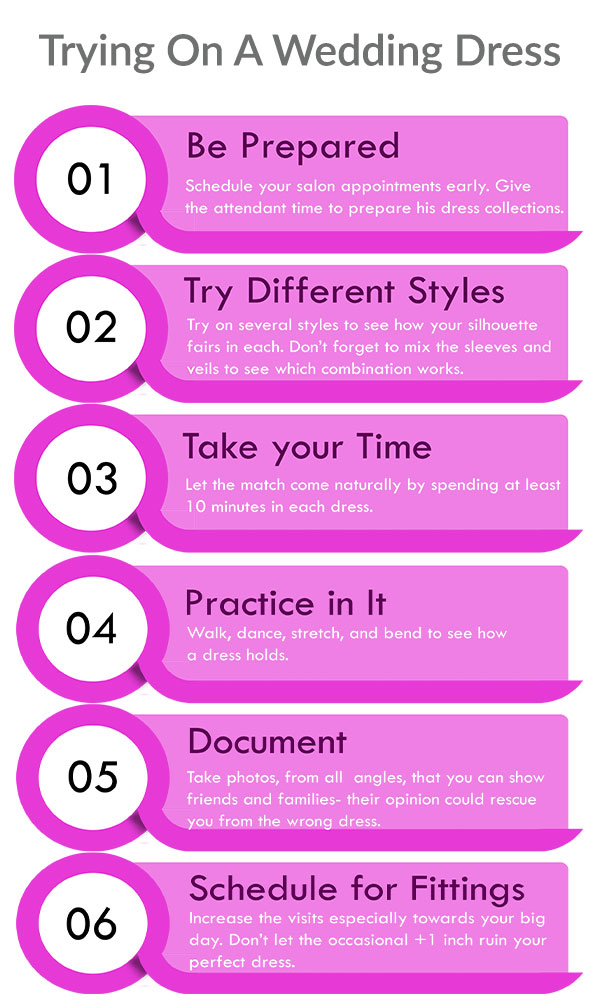
- Be Prepared
Wedding salons might not be overly busy places but the details that go to a fitting are time consuming and specialized in nature. With this in mind, make your appointment at least a day or two in advance. This will give the attendant time to prepare for your visit. Also, let the salon know about your preferences prior to the visit. That way they can prepare appropriate dresses for your perusal- that beats having to try on every other dress.
- Try Different Styles
As much as different body shapes calls for specific dress styles, it’s good to keep an open mind. Try on several styles to see how your silhouette fairs in each. Keep in mind that sleeves and veils could make all the difference, so be ready to try them out too.
- Take your Time
A dress that looks good on the mirror may not feel so good after spending one hour in it. To ensure you don’t end up with the wrong dress, spend at least 10 minutes in each dress.
- Practice in It
You will have to walk, dance, eat and do other stuff in that single dress during your big day. So, why not practice a little in the salon to see how a dress holds. This will help you to order alterations or narrow your search to a better choice.
- Document
The opinion of others could help in landing the perfect dress. If you are shopping alone, then take photos that you can show friends and family. The approach can be instrumental in choosing the best dress.
- Schedule for Fittings
Once you have settled on a dress, it’s time to schedule for fittings. This will ensure that any changes in your size are accounted for. Make the visits frequent especially towards your nuptials.
The Bottom Line
Looking for the perfect wedding dress can be a real hassle especially if you don’t know where to start. The different styles, parts and requirements that constitute your dream wedding look don’t make it any easier. Luckily for you, our detailed guide is your timely help in your hour of need.
More wedding dresses
[g-gallery gid=”11181″ random=”1″]

